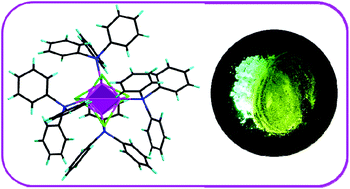Luminescence mechanochromism of copper iodide clusters: a rational investigation†
Abstract
The development of luminescent mechanochromic materials depends mainly on the possibility to rationally design them with the desired properties. Molecular copper iodide clusters constitute an unprecedented family of compounds exhibiting great changes of their luminescence properties upon mechanical stress. From previous studies, the mechanochromic properties of cubane [Cu4I4L4] (L = organic ligand) clusters have been attributed to modifications of cuprophilic interactions induced by mechanical solicitation. In this study, we ascertain our hypothesis by choosing to study the luminescence mechanochromism of a [Cu4I4(PPh3)4] cluster which presents two crystalline polymorphs exhibiting strikingly different Cu–Cu bond lengths. As forecasted, only one of these two polymorphs exhibits mechanochromic properties. Structural and optical characterization methods are reported along with structural characterization under controlled pressure allowing a precise analysis of the structural changes occurring under mechanical stress. In addition to confirming our mechanism based on enhancement of cuprophilic interactions under pressure, this study demonstrates the possibility of prediction of mechanochromic properties in the family of copper iodide compounds that constitutes a step further toward the rational design of stimuli-responsive materials.



 Please wait while we load your content...
Please wait while we load your content...